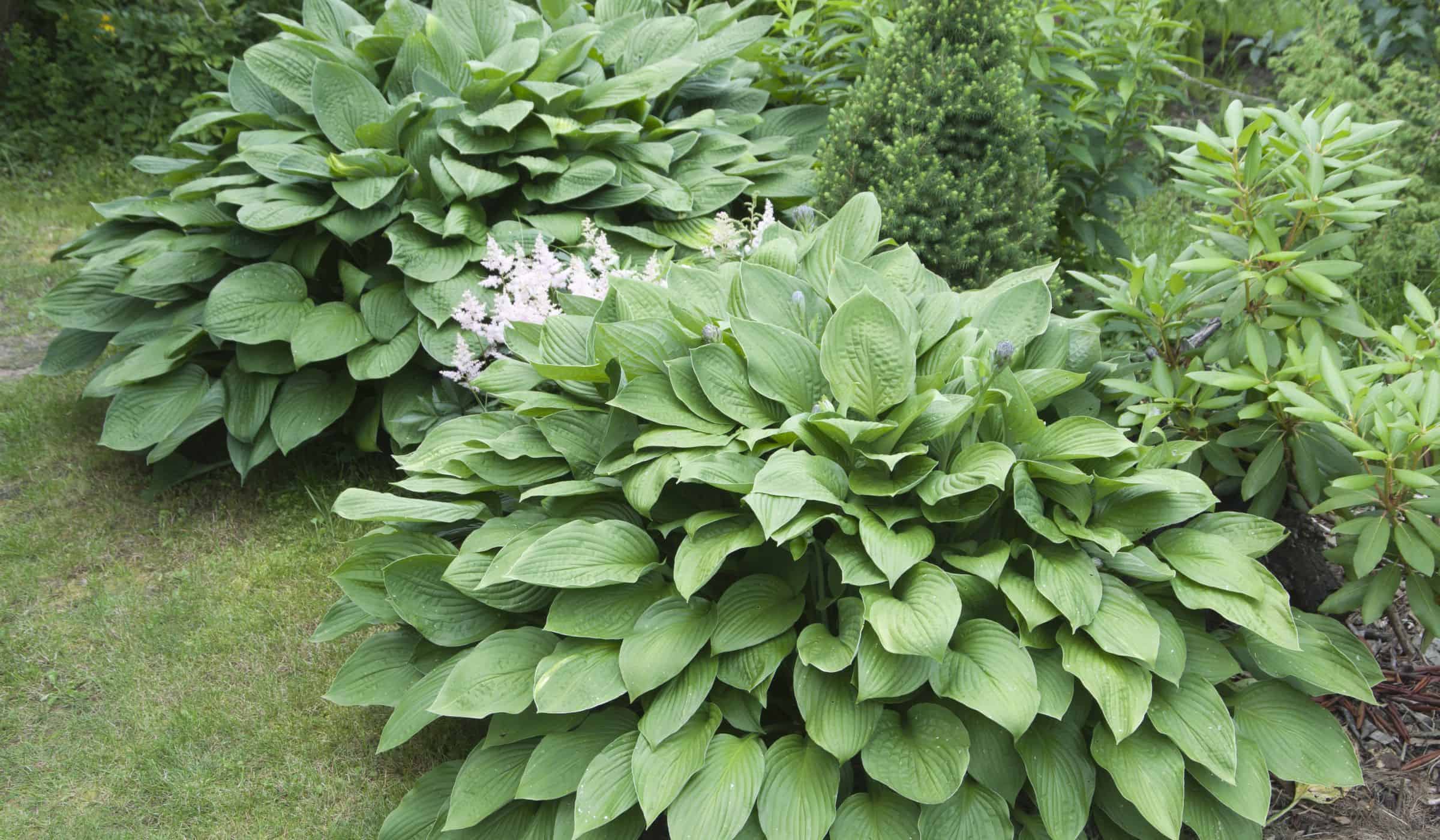The American Hosta Growers Association defines giant hosta as those that exceed 30 inches in height. There are several cultivars now that are in the 48 inch range. How big GIANT Hostas get in your garden depends on how much light they get, how much water they can get, and how deep and good the soil is. All three factors need to be optimum to achieve maximum size.
Hostas are beloved shade-loving perennials prized for their wide range of leaf colors, shapes, and textures. Their sizes span a full spectrum too, from cute miniature varieties under 6 inches up to giant cultivars exceeding 4 feet across! While genetics determine their natural size potential, proper care makes all the difference in realizing the full grandeur of big hosta varieties
Follow these 8 tips to help your hostas grow as enormous as possible
1. Select the Right Cultivars
To grow huge hostas, start by picking varieties specifically bred to reach very large proportions. Some top mammoth options include:
-
Empress Wu – 4.5 feet tall with massive 2 foot wide blue-green leaves
-
Sum and Substance – Chartreuse 4 foot wide clumps with 20 inch leaves
-
Blue Angel – Vase-shaped clumps 4 feet across with 16 inch blue leaves
-
Krossa Regal – Dense 3 foot wide mounds with intense blue 15 inch leaves
-
Liberty – 30 inch tall with 14 inch blue-green leaves edged in white
-
Seducer – 30 inch height and spread with heavily corrugated blue-green leaves
2. Give Hostas Rich, Moist Soil
Hostas thrive in nutrient-dense, moisture-retentive soil amended with plenty of organic matter. Work in several inches of compost or rotted manure before planting. Mulch well after planting to conserve moisture and feed the soil as the mulch decomposes. Locate hostas in naturally moist spots for best growth.
3. Allow Enough Space
Give each hosta adequate room to reach its mature size without crowding. Check spacing requirements for the cultivar and adjust accordingly. As a rule of thumb, allow at least 2 to 3 feet between small or medium hostas and 4 feet or more for giant varieties.
4. Water Hostas Regularly
Hostas require consistently moist soil, especially as young plants and during growth periods. Water thoroughly at the base about 1 inch per week, adjusting for rainfall. Consider installing irrigation in hot climates. Soil moisture is crucial for hostas to achieve full proportions.
5. Use a High Nitrogen Fertilizer
Hosta plants like to be fed and adding blood meal fertilizer to the soil on top of your traditional organic fertilizer amendments surrounding the plant will give it extra nitrogen. This nitrogen will help the leaves get and stay larger. Apply according to package directions in early spring.
6. Give Hostas Optimal Sun Exposure
Most grow best in part shade or morning sun only. However, gold and yellow varieties can tolerate more light. Variegated hostas often thrive in about half sun. Adjust sunlight for maximal growth based on the variety.
7. Divide Hostas when Overcrowded
If your hosta clump outgrows its space and leaves are smaller, it’s time to divide it. Carefully dig up and separate the plant in early spring, discarding woody centers. Replant divisions with roughly 3 eyes or shoots each. This rejuvenates the plants.
8. Control Snail and Slug Pests
These slimy creatures will riddle hosta leaves with holes, stunting their growth. Use organic slug baits or traps to protect your hostas. Remove any infested foliage to stimulate new growth. Keep mulch away from crowns as it shelters pests.
With the right growing conditions and care, even naturally small hosta varieties can reach surprising proportions. And giant hosta cultivars will astound you with their colossal growth when provided exactly what they need. Give your hostas some extra love and enjoy watching them grow into gorgeous, hulking specimens.
How You Can Optimize The Growing Conditions For GIANT Hosta
I like to use the analogy of comparing the needs of mice vs. elephants to the needs of miniature hosta vs. giant hosta.
On a small amount of food and water, mice can reach maturity in a matter of months. Compare that to an elephant. An elephant takes huge amounts of food and water to reach maturity over 15 to 20 years!.
With good conditions the giant hosta will reach maturity in 5 to 6 years.
The optimal light for hostas as a general rule is:
- dark greens and blues in less sun
- yellows in more sun
- variegated generally in mixed light
The hosta will get the best light if there are trees around it so that it moves with the sun.
Availability of water to the giant hostas is a very important factor. Most hostas receive about 60 inches of rainfall annually in their native habitat of East Asia.
When water is withheld, the hostas will stop growth. The crown won’t be able to hold as much food, so the plant will be smaller next spring.
Location, location, location is the largest factor in determining available water. If you’ve been gardening in the same spot for a while, you know where the wet spots are.
Moist areas are the ideal spot for the giants. We’re not talking about standing water that has no oxygen in the soil. The best spot has soil that is likely to still be moist in the hot summer months.
The Depth and Quality of the Soil

Deep rich soil is very much a factor in how large your giant hosta can grow. Here in New England we think 10 inches of loam is deep. If you are in Iowa, that is considered poor shallow soil. Ten inches of topsoil is fine. The higher the organic matter content is the better the soil will be. Incorporating 50% compost to the mix you backfill with is optimal. You can maintain a high organic content through the years by allowing a mulch to rot in place. The organic matter not only keeps nutrients in the soil and makes them available to your giant hostas, it also helps water get into and stay in the soil.
Obviously, not everyone has the “perfect” location to grow giant hostas to their potential. The solution is to amend the soil to help create a desirable site. Adding organic matter and peat moss will help with water retention. After that it is up to us to water the hostas when Mother Nature doesn’t do her part.
Giving hostas, especially giant hostas, about an inch of water every week will make it much more likely that they will grow into a huge clump.
SECRETS to Growing Huge Hosta | QUICKLY
FAQ
How long does it take for hosta to reach full size?
Why is my hosta staying small?
What is the secret to growing hostas?
Why are my hostas not getting big?
How do you make hostas grow bigger?
Proper feeding is one way to make hostas grow bigger. The best and easiest way to feed hostas is by adding a healthy layer of compost to the soil in the spring. This feeds nutrients into the soil and helps promote the soil food web.
Can hostas grow in Zone 9?
Yes, hostas can grow in Zone 9, but it can be a bit challenging as these plants typically prefer cooler temperatures .However, with the right care and conditions, you can successfully cultivate these
How do you grow a hosta plant?
Take a large hosta, divide and spread the smaller plants out in the area. Planting more of the same hosta variety will give you faster results because dividing a large plant and spreading it out will fill the area faster than waiting for less but larger plants to fill the area in. 8. Routinely Clean Around Your Hostas
Will a hosta grow bigger if left alone?
Any hosta you leave on its own will grow bigger than a hosta you divide or remove the offshoots from. Take a large hosta, divide and spread the smaller plants out in the area.
- The Ultimate Guide to Growing Strawberries in Raised Beds - August 8, 2025
- No-Dig Garden Beds: The Easiest Way to Grow a Beautiful Garden - August 6, 2025
- How to Protect and Preserve Wood for Raised Garden Beds - August 6, 2025

